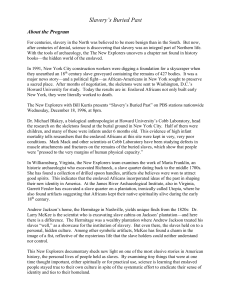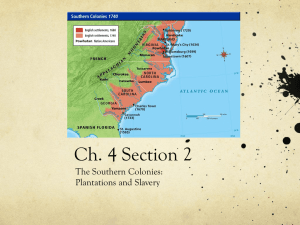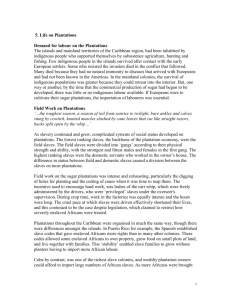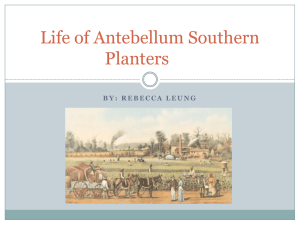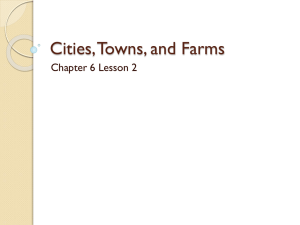The Southern Colonies: Slavery
advertisement
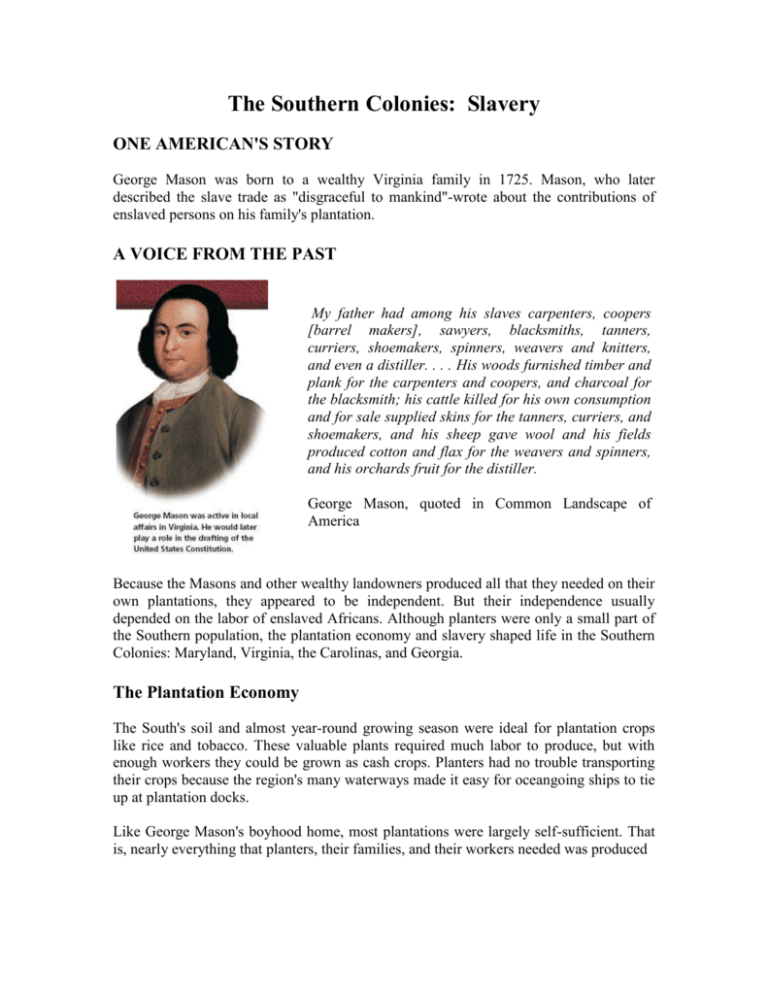
The Southern Colonies: Slavery ONE AMERICAN'S STORY George Mason was born to a wealthy Virginia family in 1725. Mason, who later described the slave trade as "disgraceful to mankind"-wrote about the contributions of enslaved persons on his family's plantation. A VOICE FROM THE PAST My father had among his slaves carpenters, coopers [barrel makers], sawyers, blacksmiths, tanners, curriers, shoemakers, spinners, weavers and knitters, and even a distiller. . . . His woods furnished timber and plank for the carpenters and coopers, and charcoal for the blacksmith; his cattle killed for his own consumption and for sale supplied skins for the tanners, curriers, and shoemakers, and his sheep gave wool and his fields produced cotton and flax for the weavers and spinners, and his orchards fruit for the distiller. George Mason, quoted in Common Landscape of America Because the Masons and other wealthy landowners produced all that they needed on their own plantations, they appeared to be independent. But their independence usually depended on the labor of enslaved Africans. Although planters were only a small part of the Southern population, the plantation economy and slavery shaped life in the Southern Colonies: Maryland, Virginia, the Carolinas, and Georgia. The Plantation Economy The South's soil and almost year-round growing season were ideal for plantation crops like rice and tobacco. These valuable plants required much labor to produce, but with enough workers they could be grown as cash crops. Planters had no trouble transporting their crops because the region's many waterways made it easy for oceangoing ships to tie up at plantation docks. Like George Mason's boyhood home, most plantations were largely self-sufficient. That is, nearly everything that planters, their families, and their workers needed was produced on the plantation. Because plantations were so self-sufficient, large cities like those in the North were rare in the Southern Colonies. The port city of Charles Town (later called Charleston) in South Carolina was an early exception. As the plantation economy continued to grow, planters began to have difficulty finding enough laborers to work their plantations. Toward the end of the 1600s, the planters began to turn to enslaved Africans for labor. The Turn to Slavery For the first half of the 1600s, there were few Africans in Virginia, whether enslaved or free. In 1665, fewer than 500 Africans had been brought into the colony. At that time, African and European indentured servants worked in the fields together. Starting in the 1660s, the labor system began to change as indentured white servants started to leave the plantations. One reason they left was the large amount of land available in the Americas. It was fairly easy for white men to save enough money to buy land and start their own farms. White servants could not be kept on the plantations permanently. As Bacon's Rebellion showed, it was also politically dangerous for planters to try to keep them there. As a result, the landowners had to find another source of labor. Planters tried to force Native Americans to work for them. But European diseases caused many Native Americans to die. Those who survived usually knew the country well enough to run away. To meet their labor needs, the planters turned to enslaved Africans. As a result, the population of people of African descent began to grow rapidly. By 1750, there were over 235,000 enslaved Africans in America. About 85 percent lived in the Southern Colonies. Enslaved Africans made up about 40 percent of the South's population. Plantations Expand The growth of slavery allowed plantation farming to expand in South Carolina and Georgia. Without slave labor, there probably would have been no rice plantations in the region's swampy lowlands. Enslaved workers drained swamps, raked fields, burned stubble, and broke ground before planting. They also had to flood, drain, dry, hoe, and weed the same fields several times before the harvest. The cultivation of rice required not only backbreaking labor but also considerable skill. Because West Africans had these skills, planters sought out slaves who came from Africa's rice-growing regions. On higher ground, planters grew indigo, a plant that yields a deep blue dye. A young woman named Eliza Lucas had introduced indigo as a successful plantation crop after her father sent her to supervise his South Carolina plantations when she was 17. The Planter Class Slave labor allowed planters, such as the Byrd family of Virginia, to become even wealthier. These families formed an elite planter class. They had money or credit to buy the most slaves. And because they had more slaves, they could grow more tobacco, rice, or indigo to sell. Small landowners with just one or two slaves simply could not compete. Many gave up their land and moved westward. As a result, the powerful planter class gained control of the rich land along the coast. The planter class was relatively small compared to the rest of the population. However, this upper class soon took control of political and economic power in the South. A foreign traveler in the South commented that the planters "think and act precisely as do the nobility in other countries." Some planters, following the traditions of nobility, did feel responsible for the welfare of their enslaved workers. Power, they believed, brought with it the responsibility to do good. Many planters, though, were tyrants. They held complete authority over everyone in their households. Planters frequently used violence against slaves to enforce their will. Life under Slavery On large Southern plantations, slaves toiled in groups of about 20 to 25 under the supervision of overseers. Overseers were men hired by planters to watch over and direct the work of slaves. Enslaved persons performed strenuous and exhausting work, often for 15 hours a day at the peak of the harvest season. If slaves did not appear to be doing their full share of work, they were often whipped by the overseer. Enslaved people usually lived in small, one-room cabins that were furnished only with sleeping cots. For a week's food, a slave might receive only around a quarter bushel of corn and a pound of pork. Some planters allowed their slaves to add to this meager ration by letting them raise their own potatoes, greens, fruit, or chicken. In spite of the brutal living conditions, Africans preserved many customs and beliefs from their homelands. These included music, dances, stories, and, for a time, African religionsincluding Islam. African kinship customs became the basis of African-American family culture. A network of kin was a source of strength even when families were separated. Resistance to Slavery At the same time that enslaved Africans struggled to maintain their own culture, they fought against their enslavement. They sometimes worked slowly, damaged goods, or purposely carried out orders the wrong way. A British traveler in 1746 noted that many slaves pretended not to understand tasks they often had performed as farmers in West Africa. A VOICE FROM THE PAST ‘You would really be surpriz'd at their Perseverance; let an hundred Men shew him how to hoe, or drive a wheelbarrow, he'll still take the one by the Bottom, and the other by the Wheel; and they often die before they can be conquer'd.” Edward Kimber, quoted in White over Black At times, slaves became so angry and frustrated by their loss of freedom that they rose up in rebellion. One of the most famous incidents was the Stono Rebellion. In September 1739, about 20 slaves gathered at the Stono River just south of Charles Town. Wielding guns and other weapons, they killed several planter families and marched south, beating drums and loudly inviting other slaves to join them in their plan to seek freedom in Spanish-held Florida. By late that afternoon, however, a white militia had surrounded the group of escaping slaves. The two sides clashed, and many slaves died in the fighting. Those captured were executed. Stono and similar revolts led planters to make slave codes even stricter. Slaves were now forbidden from leaving plantations without permission. The laws also made it illegal for slaves to meet with free blacks. Such laws made the conditions of slavery even more inhumane. The Southern Colonies' plantation economy and widespread use of slaves set the region on a very different path from that of the New England and Middle Colonies.
